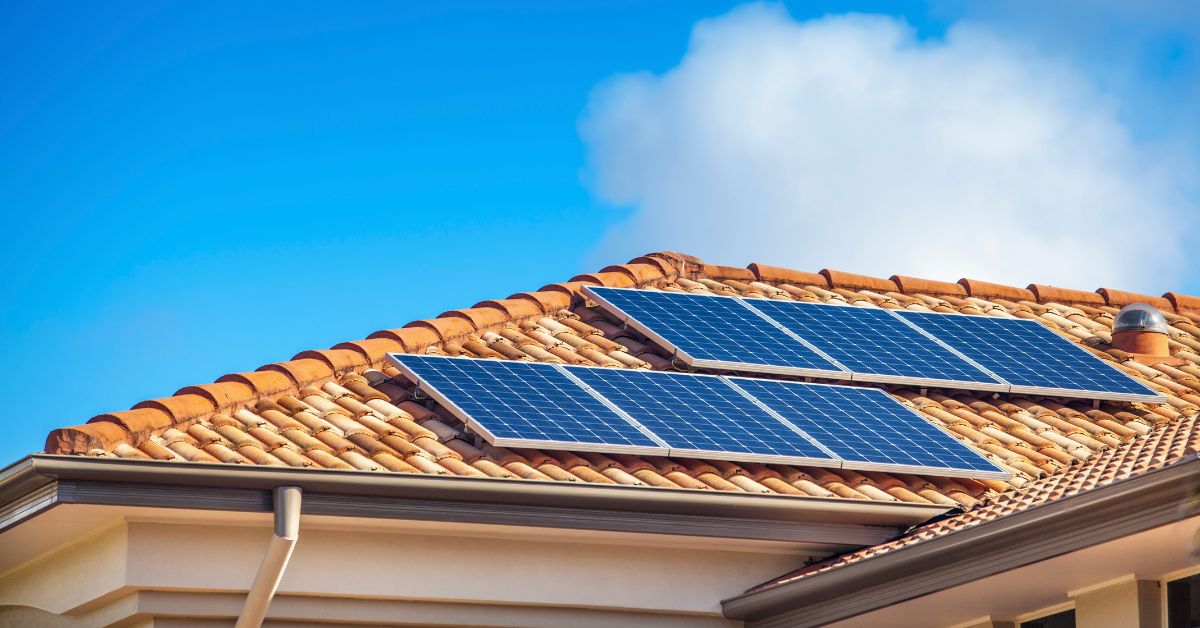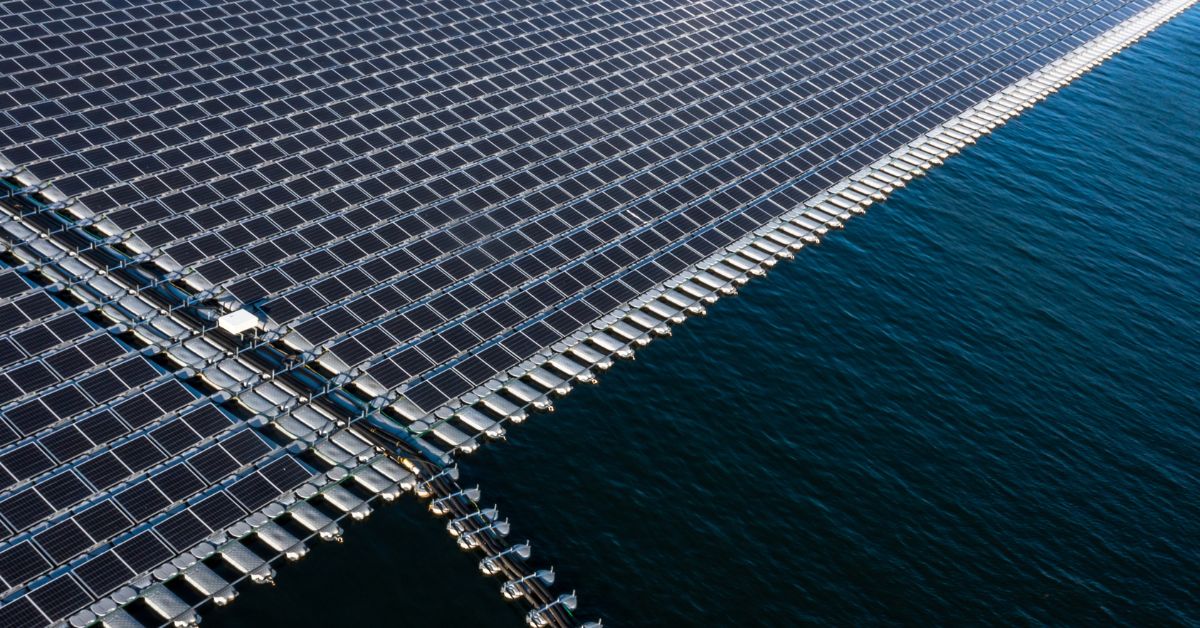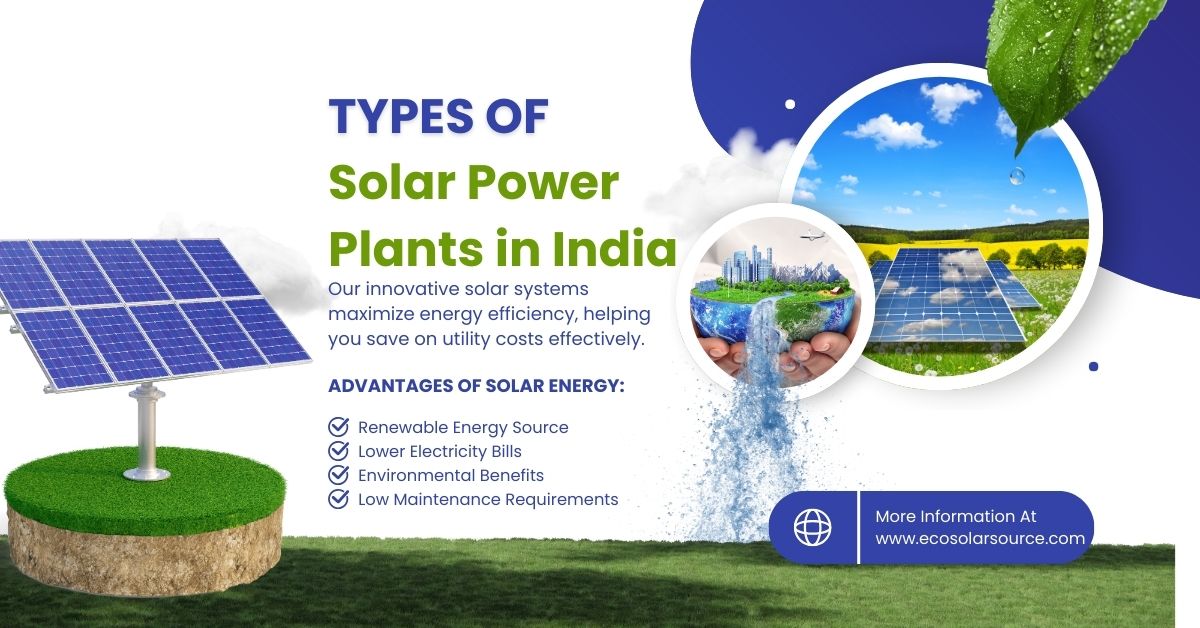Types of Solar Power Plants in India
Know the details about Types of Solar Power Plants in India, India hosts several types of solar power plants, reflecting its diverse geographical and climatic conditions. Photovoltaic (PV) solar farms harness sunlight directly using solar panels, offering flexibility for both large-scale and rooftop installations. Concentrated Solar Power (CSP) plants utilize mirrors or lenses to focus sunlight, generating steam to drive turbines for electricity.
Solar hybrid plants combine solar energy with conventional sources, enhancing reliability and efficiency. Additionally, off-grid solar systems provide power to remote areas, while floating solar farms utilize water bodies, minimizing land use. Together, these innovations contribute to India’s ambitious renewable energy goals, promoting sustainability and energy independence.
Table of Contents
Types of Solar Power Plants in India
India has emerged as a global leader in renewable energy, and solar power plays a significant role in this transformation. Blessed with abundant sunlight, the country is increasingly harnessing solar energy to meet its growing power needs, while addressing environmental concerns. The solar industry in India has seen exponential growth, particularly after the launch of the National Solar Mission in 2010. There are various types of solar power plants operational in India, each differing based on technology, application, and capacity. In this blog post, we will explore the different types of solar power plants in India and their roles in the energy landscape.
Photovoltaic (PV) Solar Power Plants
Photovoltaic solar power plants, often referred to as solar PV plants, are the most common type of solar power installations across the world, including India. These plants convert sunlight directly into electricity using photovoltaic cells. India has embraced this technology on a large scale due to its simplicity, scalability, and relatively low maintenance requirements.

Key Components:
- Solar Panels (PV Modules): These are the core components of a PV plant and consist of cells that capture sunlight and convert it into direct current (DC).
- Inverters: Inverters convert the DC produced by solar panels into alternating current (AC), which is the type of electricity used in homes and industries.
- Mounting Structures: The panels are installed on structures that either fix them in a particular orientation or allow them to follow the sun’s movement to maximize exposure.
Applications:
- Utility-Scale Solar Plants: These are large solar farms that contribute directly to the national grid. India has some of the largest solar PV plants in the world, including the Bhadla Solar Park in Rajasthan.
- Rooftop Solar Installations: PV systems are installed on rooftops of residential, commercial, and industrial buildings. The government of India provides subsidies and incentives to promote rooftop solar installations.
- Off-grid Solar Plants: These plants are used in remote areas where access to the national grid is limited. Off-grid systems provide electricity for homes, schools, and hospitals in rural and tribal regions.
Advantages:
- High scalability.
- Cost-effective in the long run, especially with falling prices of PV modules.
- Low maintenance requirements compared to other solar technologies.
- Widely applicable for residential, commercial, and utility-scale projects.
Challenges:
- PV systems are dependent on sunlight availability, making them less effective during cloudy days or in regions with lower solar insolation.
- Energy storage solutions (e.g., batteries) are required to ensure a continuous power supply, especially for off-grid and hybrid systems, but these add to the cost.
Concentrated Solar Power (CSP) Plants
Concentrated Solar Power (CSP) plants are less common in India compared to PV plants but are a key part of the country’s solar energy mix. CSP plants use mirrors or lenses to focus sunlight onto a small area to generate heat. This heat is then used to produce steam, which drives a turbine connected to a generator to produce electricity.
Key Components:
- Mirrors/Lenses: These are arranged in different configurations (parabolic troughs, solar towers, or Fresnel reflectors) to concentrate solar energy.
- Heat Transfer Fluid (HTF): Fluids like molten salt or synthetic oil are used to transfer the heat to a steam generator.
- Turbine and Generator: The steam produced is used to run a turbine, which generates electricity.
Applications:
- Utility-Scale Power Generation: CSP plants are suitable for large-scale power production, often in conjunction with other forms of power generation.
- Hybrid Systems: CSP can be combined with fossil fuel plants to create hybrid systems, reducing the overall carbon footprint while ensuring reliability.
Advantages:
- CSP plants can store thermal energy, allowing for power generation even after the sun has set.
- More efficient at utility-scale than PV in regions with high direct sunlight.
- Can integrate with other energy sources (e.g., fossil fuels or biomass) for a hybrid approach.
Challenges:
- CSP plants require large amounts of land and are most effective in regions with high direct solar insolation (e.g., Rajasthan).
- High initial costs compared to PV systems.
- Complex technology that requires skilled maintenance.
Floating Solar Power Plants
Floating solar power plants, also known as floating photovoltaic (FPV) systems, are a relatively new concept in India. These plants consist of PV modules mounted on floating platforms on water bodies like lakes, reservoirs, or ponds. Floating solar plants have gained popularity in India, where land availability is a significant constraint.

Key Components:
- Floating Platforms: These are the structures on which PV modules are mounted. They keep the panels above water while allowing them to track sunlight.
- Mooring Systems: These are used to secure the floating platforms to the bed of the water body to prevent drifting.
- PV Modules and Inverters: Similar to land-based PV plants, these components capture and convert solar energy into electricity.
Applications:
- Reservoirs and Lakes: Floating solar systems are ideal for large water bodies like reservoirs, where land-based installations are not feasible.
- Hydropower Dams: FPV systems can be installed on hydropower dams, effectively combining solar and hydropower to enhance power generation.
Advantages:
- Efficient use of space, especially in land-scarce regions.
- Floating solar plants help reduce water evaporation from reservoirs, providing a dual benefit in water-scarce areas.
- The cooling effect of water bodies improves the efficiency of solar panels.
Challenges:
- Higher installation and maintenance costs due to the unique environment.
- Potential environmental concerns regarding aquatic ecosystems.
- Limited to regions with suitable water bodies.
Hybrid Solar Power Plants
Hybrid solar power plants combine solar PV or CSP with other forms of energy generation, such as wind power, biomass, or fossil fuels. This combination enhances reliability and ensures a more stable power supply, especially during periods when sunlight is unavailable. In India, hybrid solar plants are increasingly being explored as a solution to the intermittency of renewable energy.
Key Components:
- Solar PV or CSP: The primary component of the plant, responsible for capturing solar energy.
- Other Energy Sources (Wind, Biomass, or Fossil Fuels): These provide power when solar energy is unavailable, ensuring continuous electricity generation.
- Battery Storage Systems: In some hybrid systems, batteries are used to store excess energy generated during the day for use at night.
Applications:
- Rural Electrification: Hybrid systems are ideal for remote and off-grid areas where reliable power is needed.
- Utility-Scale Projects: Hybrid plants can be used for large-scale power generation, reducing the reliance on fossil fuels.
Advantages:
- Improved reliability and stability of power supply.
- Optimal use of multiple renewable energy sources.
- Potential to reduce greenhouse gas emissions by replacing fossil fuel-based generation.
Challenges:
- Higher initial costs due to the complexity of integrating multiple energy sources.
- Requires advanced technology and skilled maintenance.
Solar-Wind Hybrid Plants
Solar-wind hybrid power plants combine two renewable energy sources—solar and wind—to generate electricity. These plants have the advantage of tapping into the complementary nature of wind and solar energy; while solar power is more effective during the day, wind energy can often generate power at night or during cloudy weather.
Key Components:
- Solar PV Modules: Capture sunlight and generate electricity during the day.
- Wind Turbines: Capture wind energy, especially during night-time or cloudy conditions.
- Inverters and Controllers: Manage the integration of both energy sources to ensure a stable power supply.
Applications:
- Utility-Scale Power Generation: These hybrid plants are ideal for large-scale power production.
- Rural Electrification: In areas with both high solar and wind potential, hybrid plants can provide reliable electricity to remote communities.
Advantages:
- Better use of available natural resources by tapping into both solar and wind energy.
- Reduces the intermittency problem of single-source renewable energy systems.
- Potential to provide continuous power supply even during varying weather conditions.
Challenges:
- Requires detailed site assessment to determine the viability of both solar and wind resources.
- Higher upfront costs due to the need for both solar and wind energy infrastructure.
Community Solar Power Plants
Community solar power plants are designed to serve multiple households or small communities. These plants allow residents, especially those who cannot install solar panels on their properties, to invest in a shared solar project and receive benefits from the electricity generated.

Key Components:
- Shared PV Panels: A community or cooperative invests in a single solar power plant that serves multiple households.
- Virtual Net Metering: This technology allows residents to receive credit on their electricity bills for the power generated by their share of the community solar plant.
Applications:
- Residential Communities: Particularly useful in urban areas where individual rooftop installations may not be feasible.
- Rural Electrification: In rural areas, community solar plants can be used to provide power to villages and remote settlements.
Advantages:
- Provides access to solar energy for people who cannot install individual systems.
- Reduces individual installation costs by pooling resources.
- Supports community ownership and local job creation.
Challenges:
- Requires coordination and investment from multiple stakeholders.
- Regulatory and policy challenges, especially in states without virtual net metering regulations.
Canal Top Solar Power Plants
Canal top solar power plants are a unique and innovative approach to solar energy generation in India. These plants involve installing solar PV panels over the surface of canals, using the existing infrastructure to generate electricity while also reducing water evaporation.
Key Components:
- PV Modules: Installed on structures that span the width of canals.
- Mounting Structures: Specially designed to be installed over water, these structures provide support for the PV panels.
Applications:
- Irrigation Canals: These solar plants can be installed over irrigation canals, helping to reduce water evaporation while generating electricity for nearby regions.
- Water Supply Canals: Similar applications can be found on water supply canals that serve urban areas.
Advantages:
- Efficient use of space, as the solar plant does not require additional land.
- Helps reduce water evaporation from canals, which is particularly beneficial in water-scarce regions.
- Provides shade to canals, helping maintain water quality and reducing algae growth.
Challenges:
- Higher installation costs due to the complexity of building over water.
- Maintenance can be challenging due to the location of the panels over canals.
FAQs About Types of Solar Power Plants in India
Q1. What are the main types of solar power plants in India?
India primarily has two types of solar power plants: Photovoltaic (PV) Power Plants and Concentrated Solar Power (CSP) Plants. PV plants convert sunlight directly into electricity using solar panels, while CSP plants use mirrors or lenses to concentrate sunlight onto a small area to produce steam that drives a turbine.
Q2. How does a Photovoltaic (PV) Power Plant work?
A PV power plant works by using solar panels composed of many solar cells. When sunlight hits these cells, it creates an electric field that generates direct current (DC) electricity. This DC electricity is then converted to alternating current (AC) electricity using an inverter for use in homes and businesses.
Q3. What is a Concentrated Solar Power (CSP) Plant?
CSP plants use mirrors or lenses to focus sunlight onto a receiver that collects the concentrated solar energy. This energy is used to heat a fluid, producing steam that drives a turbine connected to a generator, thus producing electricity.
Q4. What are the advantages of solar power plants in India?
Solar power plants help reduce dependency on fossil fuels, lower greenhouse gas emissions, provide energy security, and create job opportunities. They also help in achieving the government’s renewable energy targets and reducing electricity costs in the long run.
Q5. What is the capacity of solar power plants in India?
As of 2024, India has set ambitious targets for solar energy capacity, aiming to achieve 280 GW of solar power by 2030. The current installed capacity exceeds 60 GW, with a significant share coming from large-scale solar parks.
Q6. How are solar power plants financed in India?
Solar power plants in India can be financed through various means, including government subsidies, loans from financial institutions, investments from private companies, and international funding. The government also offers incentives and tax benefits to promote solar energy projects.
Q7. What is the role of government policies in solar power development?
The Indian government plays a crucial role in promoting solar energy through various policies, including the National Solar Mission, which aims to enhance solar energy generation, provide subsidies, and promote research and development in solar technologies.
Q8. What challenges do solar power plants face in India?
Some challenges include land acquisition issues, regulatory hurdles, grid connectivity problems, high initial investment costs, and variability in solar energy generation due to weather conditions.
Q9. What are hybrid solar power plants?
Hybrid solar power plants combine solar energy with other forms of energy generation, such as wind, biomass, or conventional sources like coal or gas. This helps in providing a more stable and reliable energy supply by compensating for the intermittent nature of solar energy.
Q10. What is the future of solar power in India?
The future of solar power in India looks promising, with increasing investments, advancements in technology, and supportive government policies. The focus is on expanding solar capacity, improving energy storage solutions, and enhancing grid infrastructure to support the growing demand for renewable energy.
India’s solar energy sector is diverse, with different types of solar power plants catering to various needs and challenges. From large-scale utility plants to innovative floating and canal-top installations, each type of solar plant contributes to the country’s goal of achieving energy security and reducing its carbon footprint. As India continues its rapid growth in solar energy, the future promises even more advancements and integration of technologies such as battery storage, AI-based energy management, and hybrid systems, further solidifying India’s position as a leader in renewable energy.
Click here to learn more about Types of Solar Power Plants in India
Click here to learn more about the Difference Between Active and Passive Solar Energy Systems

